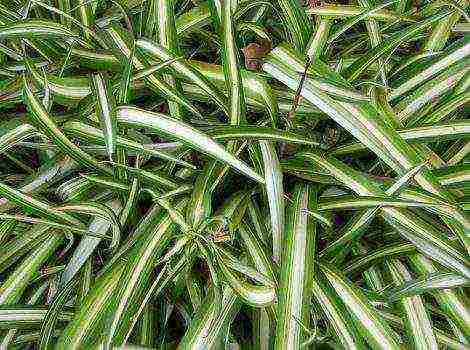Content [show]
Most people think at least once about running their own business related to agriculture, but which area of income to choose is a very difficult question. Raising gobies for meat at home is perhaps one of the simplest and fastest-paying types of entrepreneurship.
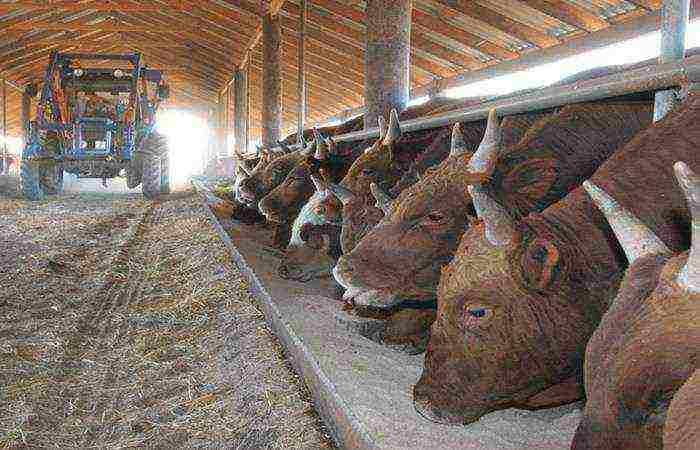
Raising gobies for meat
Where to start growing?
First you need to understand: for what purpose the bulls will be raised. There are many options for selling the final product: own consumption, distribution to a narrow circle of people, the sale of meat in the kitchens of cafes and restaurants, the production of meat products and their further sale in stores or independent trade.
The first option can hardly be called entrepreneurship; rather, it will bring moral pleasure from keeping livestock and further consumption of meat, in the quality of which you will be completely sure.
After the final decision to engage in such an area as raising bulls, it will be time to purchase calves. You should contact farms specializing in the identical direction of your future business. The most popular beef cattle breeds are: Devonian, Russian Komoloy, Shorthorn, Galloway, Aberdeen-Angus and some others.
Diet of gobies
A good diet is an important part of fattening bulls. Not only the rate of weight gain of the animal, but also the quality of meat will depend on it.
One of the possible combinations of feed ration: corn silage, wheat straw, meadow hay, salt. You can add pulp, meal, other concentrates, such as bone or fish meal. Do not oversaturate feeding with a large amount of feed. The best solution would be to contact a specialist who will help you calculate the exact amount of giving the components of the diet.
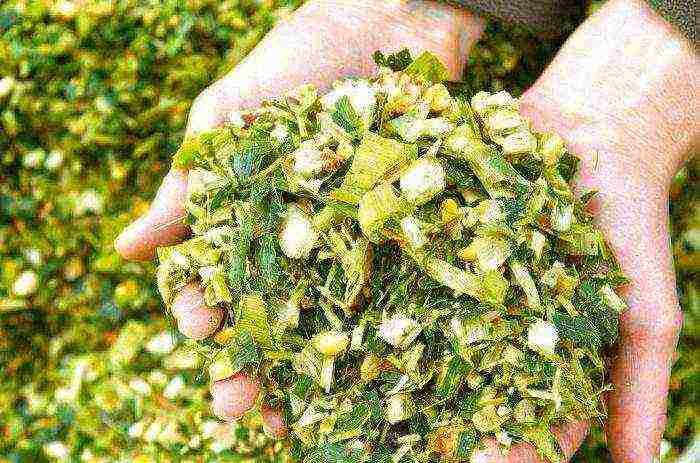
Corn silage
Possible summer diet:
- concentrates 2 kg;
- green food 28-35kg.
For the winter period:
- juicy feed 18-21 kg;
- hay 4-5kg;
- straw 2-4 kg;
- compound feed 3 kg;
- salt 50 g
If necessary, the animals are given various supplements to balance the nutrient content of the body.
Reference. Gobies need to be constantly given water or provide constant access to it.
Feeding technology
Nutrition should be monitored from the 20th day of the calf's life, that is, after weaning from the cow. At this age, they begin to form the correct work of the digestive tract, aimed at plant food, instead of the usual milk.Giving roughage at an early age will consume a lot of energy from the calves to digest them, so additional enzymes must be fed.
The additional intake of enzymes will not only speed up the digestion of feed and increase the weight gain, but also prevent undigested feed masses from "lodging" in the intestines. Such stagnation of food can lead to serious intoxication of the body.
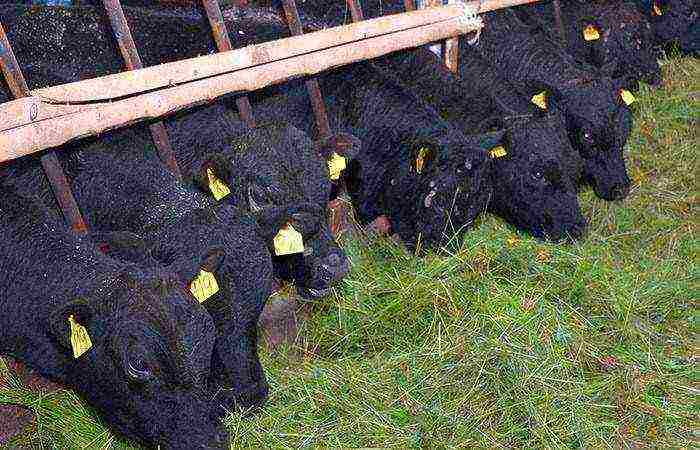
Going to hay
After a smooth transition from milk to hay, cereals and grasses, from the age of 3 months, feed rich in protein is added to the diet. Upon reaching a live weight of 300 kg, the rearing period ends and fattening begins. If in the first the average daily gain can reach a maximum of 800 g, then for fattening this figure rises to 1250 g (in outstanding meat breeds it can be more).
Caring for bulls
Breeding bulls involves competent care, which includes not only balanced feeding and a warm room for the winter, but also the observance of the following points:
- vaccination of calves and veterinary examination;
- periodic examination by a veterinarian as the bull grows. The sudden onset of a disease, especially of an infectious nature, can deprive the expected profit from the sick animal;
- start morning grazing after the dew has subsided;
- observe zoohygienic conditions of detention: dry floors with replaceable bedding, sufficient lighting, no drafts, maintaining the optimum temperature (at least 10 degrees) of air and humidity;
- providing animals with active exercise. If conditions permit, then the bulls should be grazed on a leash as little as possible.
How does castration of bulls affect the amount of meat?
During castration, the sexual function of males is disrupted, and, therefore, a hormonal failure occurs, affecting metabolic processes in the body. In castrated individuals, the formation of adipose tissue increases, while muscle growth is inhibited. That is why "untouched" animals benefit from the amount of meat.

Castration of bulls
From non-castrated bulls, tough and lean meat is obtained, and from castrated meat, fatty and tender, has a more pronounced taste. If you want to receive the second version of the product, then the recommended age for castration is 2 months. It is advisable to carry out the operation before the beginning of the grazing period.
Pros and cons of breeding
Positive sides:
- a large number of options for the sale of products;
- very small cash investments at the initial stages, especially if there is already a site and the minimum necessary inventory for elementary buildings;
- the ability to independently control the bulls;
- fast payback.
Flaws:
- you will need to invest a lot of physical labor or additionally spend on hired workers;
- the risk of possible competition in the “meat” market.
How much can you earn?
Before you can make money, you have to invest. If you have a large land plot, this will greatly facilitate the task, but otherwise you will have to spend money on:
- land acquisition;
- construction of premises for keeping cattle;
- arrangement of the barn (feeders, drinkers, floor coverings);
- purchase of young animals (price category from 5 to several tens of thousands of rubles, depending on the breed);
- feed costs (approximately 15-20 thousand rubles per animal per year).
As a result, the investment can vary from 250 to 500 thousand rubles. Large costs are not excluded.
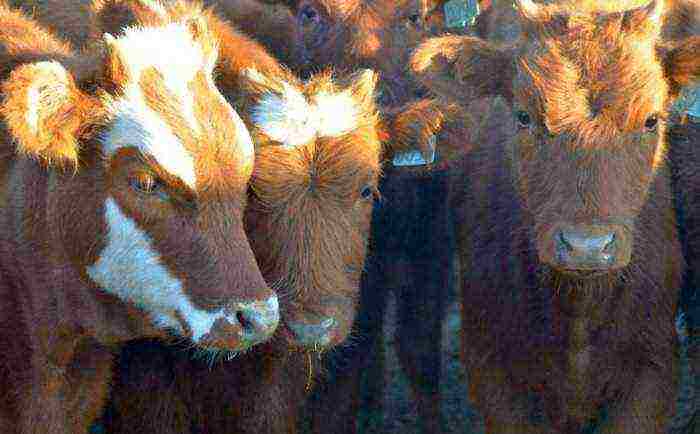
Gobies for slaughter
Breeding bulls for meat lasts from 18 to 20 months. It is at this age that they reach their optimal live weight, after which they can be sent for slaughter. Estimated weight of bulls at the end of feeding is 450-650 kg. The meat yield from each carcass will be 60-70%.
For example, your bull is not the most outstanding and weighs 450 kg, then you will get about 270 kg of meat from it. With an average price of veal for 1 kg of 300 rubles, one head will get 81 thousand rubles.Multiply this figure by the planned number of heads in the herd - this is only a net yield from meat. The remaining parts of the carcass can also be sold - also additional income. According to such calculations, the agricultural business will pay off within 1-2 years.
Reference. If it is planned to sell meat to large points of sale, then registration of entrepreneurial activity and control of meat by a veterinary sanitary examination will be required.
Conclusion
Growing bulls at home can bring tangible profits to the owner of this business. The main thing is not to be afraid to start a "farming" business, to provide proper care for animals, to find in advance the most profitable option for selling meat, and not to forget about the use of physical labor, which will be necessary to maintain the economy, especially at the initial stage.
»At home
Fattening bulls
The appearance in a household where there is at least one cow, a young bull, is not considered a rarity, but many owners, fearing difficulties with feeding and keeping it, prefer to immediately sell such an animal to breeders, or for meat, which from an economic point of view is not the right decision, since with proper fattening, a bull can reach over 400 kilograms of live weight, while its value will increase tenfold.
Diet for feeding gobies
Bulls They are able to gain live weight faster than cows, and already by the age of 12 months weigh up to 300 kilograms, therefore their maintenance and breeding is extremely beneficial for a farmer who plans not only to make money on the sale of meat, but also to leave himself considerable parts of the carcass for personal needs.
Bulls are not picky in their diet, they eat almost everything that they are given, and since no one is going to milk them, the taste and smell of feed does not play a role in fattening bulls.
The daily diet of young calves and bulls must necessarily include milk, both whole and skimmed, hay, roughage and dry feed, root crops, concentrates, various additives that can affect the growth rate of the animal and the absorption of feed by them.
Calves who have not reached six months of age must consume more than 200 liters of whole milk and skimmed milk. This rule applies to bulls of beef breeds, while dairy bulls by this time should consume a little less than 200 liters of whole milk and 600 skimmed milk. In the first week of life, the bull should be fed on milk alone; dry food in the form of hay can be introduced only in the second week of the calf's life. This amount of milk allows the bull to gain up to 800 grams of weight per day.
In addition to hay, succulent meadow and field grasses are introduced into the diet of spring calves, feeding with which is the best beginning of intensive fattening aimed at bringing the bull to the maximum possible body weight.
Experienced farmers are well aware that the longer the calf is fed milk, or at least whey, the faster it grows. If there are several cows on the farm and the mass production of cheeses, the whey remaining after this process is also strongly recommended to be given to bulls, diluting potato, carrot and other peelings with it.
An adult cow eats up to 70 kilograms of hay and other feed per day, but in the bull's diet the amount eaten should be increased to 100-120 kilograms, including green, dry, coarse and concentrated feed.
They feed the bulls 2-3 times a day, trying to replace half of the feed in the usual daily diet with silage, and in the absence of such other nutritious feeds - corn, leguminous hay and wheat. Of particular benefit to bulls is the introduction of corn leaves into the diet.
Fattening for meat at home
Bulls are left in households in two cases - for meat and for breeding.For breeding bulls for meat, they must be provided with a large amount of high-quality and nutritious feed that can have a positive effect on the animal's weight gain.
In animal husbandry, it is generally accepted to raise bulls up to 15-20 months maximum, after which they slaughter and further sale of meat. Enhanced feeding of bulls lasts throughout the entire period of rearing, but in the last three months before slaughter, animals are fed especially intensively, combining such feeding with restricting the movement of livestock. Most of the time, bulls intended for fattening spend in the barn, being tied to their stall with several chains or ropes, which is necessary due to their steep disposition, which can cause clashes with other animals and even humans. In addition, limiting movement allows you to gain weight faster than grazing bulls in a herd, as is the case with cows. In addition, in order to help build up their appetite, bulls are taken to fresh air every day and forced to wander around the pen for several hours at a time, after which they are immediately given a large amount of swill and dry hay.
The raising of bulls for the purpose of obtaining meat on large livestock farms is carried out according to specially created feeding schemes, which provide that the animal must gain at least 600 grams of weight per day. In the household, it is also advisable to use such schemes, since it allows you not to make mistakes when feeding the bull, not to overfeed or starve the animal, due to your own erroneous ideas about raising it.
In addition, such a scheme is easy to draw up on your own, guided by the following provisions:
- Gobies at the age of 1-2 months are fed exclusively with milk and skim milk, with the addition of a certain amount of hay, or well-dried green grass. Such feeds contribute to the rapid weight gain of the animal, but they are effective only at the initial stage of feeding, since they do not contribute to the development of the size of the stomach, which directly affects the amount eaten. Gobies are taught to coarse dry feed from the second week of life, feeding them a little hay and dry wheat groats
- It is quite difficult to fatten bulls at the age of 3-6 months, therefore farmers resort to various tricks, trying to feed animals a feed rich in protein, which has a beneficial effect on muscle growth and, accordingly, on the amount of meat. In the period from 6 to 9 months, the muscle mass of calves comes to an optimal balanced state, therefore, during this period, calf meat is considered the most delicious and nutritious.
- To build muscle mass in summer, calves are almost completely transferred to pasture, while in winter they are given large quantities of hay, silage and haylage.
If the farm has a large amount of potatoes, it is advisable to feed the bulls with this product. At the end of autumn, it is potatoes that can become the product that can contribute to a significant increase in bulls' weight. In addition to potatoes, bulls are also fed pumpkins, watermelons, fodder watermelons and zucchini. Before feeding vegetables and fruits, it is necessary to rinse several times with running water, and also inspect for the beginning of decay processes, mold and the like. Before distributing the root vegetables to the feeders, they should be cut and immediately given to the cows to avoid blackening. At the end of the harvesting of cereals, bulls should be given finely chopped spring straw, chopped fodder beets, corn silage, oats and other feed available on the farm.
An important component of feeding is the presence in the feed given to bulls of a large number of proteins, proteins, fats, carbohydrates, trace elements, minerals, vitamins that can increase the weight of the animal.
Calves, put on the right fattening, outwardly extremely well-fed, rarely get sick and eat well.A special place in fattening is occupied by the percentage of coarse, dry and succulent feed in the diet of both a young calf and an adult bull.
Keeping a bull in an ordinary home courtyard is not at all easy, but it is quite possible, because with proper feeding, just one bull can help out a lot of money and get a lot of high-quality meat.
To feed one bull a year, a few hundredweight of hay is enough, the same amount of compound feed, a large stock of straw, chaff, silage, haylage, dry corn and other feed available on the farm.
Before starting fattening, it is better for the farmer to obtain consultation check with your veterinarian and make sure that the available feed is sufficient to keep the bull from malnutrition during the winter. Correct feeding implies an increase in the weight of a bull by the first year of his life, 7-8 times compared to what he had at birth.
The quality of feeding depends on when the bull is slaughtered. Farmers planning to slaughter bulls by autumn intensively feed the bulls throughout the spring and summer, while those who plan to leave the bull for the winter do not, trying to gradually transfer the animal to cheap feed.
The final stage of fattening is considered to be feeding, which begins 1-2 months before slaughter. For feeding, it is necessary to have at least one high-quality pasture of at least 3 hectares for one animal. The bull can be on the walk all daylight hours, always in a tied state, which does not allow him to move quickly and thereby lose the weight he just walked.
An important rule of feeding is the observance of clear charts feeding, as well as its gradual change. A sudden switch to green and succulent food in the spring can poison the animal and be fatal.
In addition to the main feed for fattening, bulls are also given a certain amount of table salt. The norm of salt per bull is from 50 to 100 grams per day, depending on the weight of the bull.
At the end of fattening, the bull should weigh over 300 kilograms, have rounded sides, a large thick neck, round head and correct posture. Thinness when the bull consumes a sufficient amount of nutritious food may indicate the presence of a latent disease in the animal. It makes sense to feed such a bull, even in a household, is not profitable until it is completely emaciated, it is best to pass it on for meat.
The effect of castration on the weight of a bull when fattening
Most farmers castrate bulls at an early age, which saves them from the need to fight the steep temper of the bull in the future, but negatively affects the feeding process itself. Bulls that have not undergone the castration procedure grow and gain muscle mass several times faster than castrated ones, reaching one year of age, such bulls weigh on average 20 kilograms more than castrated ones, in the future this difference will only increase.
Castrated bulls consume more feed, while their meat is more fatty, therefore it is not suitable for those who follow a diet. Castration is usually carried out before the calf is 3 months old, which negatively affects the development of muscles and can lead to severe obesity. Experienced farmers try not to do this, castrating bulls when they reach the age of one year, which does not in any way affect their muscle mass gain.
Thus, it is quite profitable to fatten bulls for meat in a small-scale farming environment, if you have your own range and stocks of feed, you will practically not have to take care of the bull, the main thing is not to forget about feeding the animal three times a day, as well as having access to drinking water. It should be noted that water should be given no more than once a day, in quantities that can quench the animal's thirst, but not cause loss of appetite, which should not be allowed in any case.
How to raise calves at home
Raising calves at home requires a lot of effort, especially during the dairy season. But if properly cared for, raising calves on your own will prove to be a much more profitable process than purchasing an expensive adult calf.
Calving a cow and caring for a newborn
The cow carries the baby for 9 months. When calving begins, the cow is moved to a fenced-in area covered with clean straw. The birth is often natural and correct. The animal pushes during attempts and pushes a bluish-red bladder with amniotic fluid from the vagina, which soon bursts. The front legs of the calf appear first, then the head, then the rest of the body. You should not help and pull the calf if the birth is normal. In case of complications, you should ask for help from specialists or experienced neighbors.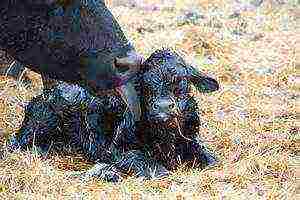
The calf lies at first, resting and gaining strength. At this time, it is necessary to separate the umbilical cord: cut it off with clean scissors or tear it off by hand. In this case, it is necessary to firmly grip the part that remains with the newborn so that bleeding or injury does not occur near the abdomen. Rinse the umbilical cord with 7% lysol solution.
The baby comes out of the womb wet due to amniotic fluid. Usually the cow licks it herself and warms it. If she does not do this, it is necessary to wipe and dry it yourself so that he does not catch a cold. After this procedure, the calf should be placed in a dry and slightly cool place without drafts. Then there is a hardening of a small organism, a delay in the development of microbes and a decrease in the risk of morbidity, which will greatly facilitate keeping the calf at home.
How to set up feeding
With proper housekeeping, it is advised that when raising calves during the dairy period, do not allow babies to be fed with the uterus. The cow usually gives much more milk than the baby needs. He can drink an excessive amount and the young body will not be able to assimilate it, which will lead to disorder.
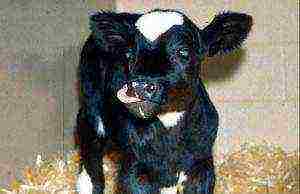 It may be the other way around. The calf will not have enough strength to suck the cow clean, which is why her milk yield will soon decrease.
It may be the other way around. The calf will not have enough strength to suck the cow clean, which is why her milk yield will soon decrease.
You can also try:
- do not let the baby suck out milk to the end and feed it with his hands, but in this case, the cow may begin to retain milk
- milk, then attach the calf, but then the owner will receive the most liquid part, and the fatty afterbirth will go to the young animal, which is also unprofitable.
Livestock breeders recommend training calves to feed from a bucket or gang.
Calf feeding
The feeding ration depends on the age of the young. Conventionally, the rearing of calves is usually divided into periods:
- Milk - from birth to 3-4 months.
- Post-milk - from 3-4 months to 6 months.
- Fast growing - from 6 to 12 months.
- Final - from one to one and a half years.
The first week of life, the newborn is fed with colostrum, which is secreted by a cow. It differs from milk in consistency and taste, because it includes more proteins and mineral salts, 4–5 times and 2 times, respectively. Colostrum is fed to the baby 3-4 feedings, 1.5 liters daily. This special nutrition is important for further stimulating growth and developing immunity to various diseases.
 At the same time, they begin to give fresh skim milk (return), warmed up to 35–37%. At the same time, they gradually accustom themselves to hay. Better if it is a vitamin, mowed before flowering plants. From the age of 25 days, they begin to give hay infusion. To prepare it, you need to grind the hay and fill it with boiled water heated to 70–80 degrees, at the rate of 6–7 liters per 1 kg of hay. The broth must be infused for 5–6 hours and drained. First, they give a dose of 0.25 liters, gradually this figure reaches 5 liters.
At the same time, they begin to give fresh skim milk (return), warmed up to 35–37%. At the same time, they gradually accustom themselves to hay. Better if it is a vitamin, mowed before flowering plants. From the age of 25 days, they begin to give hay infusion. To prepare it, you need to grind the hay and fill it with boiled water heated to 70–80 degrees, at the rate of 6–7 liters per 1 kg of hay. The broth must be infused for 5–6 hours and drained. First, they give a dose of 0.25 liters, gradually this figure reaches 5 liters.
Calves aged from six months to 1 year are transferred to solid food. The daily portion consists of 6-7 kg of carrots and beets, 1 kg of straw, 3-4 kg of hay, 0.5 kg of concentrates, 4-5 kg of silage, 25 g of salt and feed phosphate-containing substances or chalk.The menu for a one-year-old calf consists of 7-8 kg of beets, carrots or potatoes, 5 kg of hay, 6-8 kg of silage, 2 kg of straw, 0.5-1 kg of concentrated feed, 40-45 g of salt and 30-35 g. feed phosphate-containing substances or chalk.
Daily routine and place of detention
Raising calves during the dairy period requires a correct and precise daily routine. Determine the time of feeding, cleaning the room and hygiene of the baby himself. It should be adhered to to avoid morbidity in the calf.
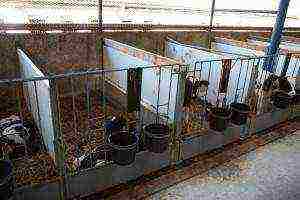 First, the newborn is placed in a cage standing on legs 30–40 centimeters high. The floor should be grated so that waste does not remain in the pen. To ensure comfort and warmth, cover the bottom with straw, preferably wheat or rye, with a layer of at least 30 centimeters. The top of the litter needs to be re-matted every day and can be completely replaced once a month. Never use wood shavings or wet straw, as this can make your baby sick.
First, the newborn is placed in a cage standing on legs 30–40 centimeters high. The floor should be grated so that waste does not remain in the pen. To ensure comfort and warmth, cover the bottom with straw, preferably wheat or rye, with a layer of at least 30 centimeters. The top of the litter needs to be re-matted every day and can be completely replaced once a month. Never use wood shavings or wet straw, as this can make your baby sick.
After 20 days, the calf is transferred to the calf shed, first in a separate cage, then in a general one, designed for a maximum of 6 animals. The calf rearing room must be dry. If this is difficult, then place a bowl of quicklime in the corner, which absorbs excess moisture. Also, wood ash should be poured on the floor so that it clears the air and absorbs the ammonia smell from urine.
Walking
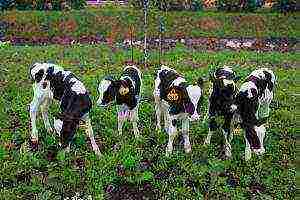 A calf of 3-4 days of life can be released from the cage, but for now it should only walk indoors. Starting from 10 days of age, the baby is released into the pen for 5-10 minutes in calm weather. Walking time is gradually increased to 1.5-2 hours.
A calf of 3-4 days of life can be released from the cage, but for now it should only walk indoors. Starting from 10 days of age, the baby is released into the pen for 5-10 minutes in calm weather. Walking time is gradually increased to 1.5-2 hours.
In the first months, it is necessary to train the calves to graze and feed on abundant young grass growing on solid ground. The first week grazing lasts 1-2 hours, the second - already 4-5, on the third - it's already 8-10.
Also, calves can and should be bathed in reservoirs with running water during the warm season.
Fattening gobies for meat
After the birth of newborn animals, the farmer thinks about whether they are suitable for further breeding of a dairy farm or for raising calves for meat. The diet and conditions of detention depend on this.
If there is a choice, calves from large dairy cows should be left for breeding from the third to the eighth calving. Firstborns are usually too weak, since the mother herself is not yet physiologically developed enough. Old-born animals are also unlikely to produce healthy offspring.
However, the mother's assessment should not be the determining factor, take a closer look at the newborn:
- large calf with a wide head and shiny coat, stands firmly on its feet, gallops, hums loudly, has a great appetite - a good option for breeding development
- a small calf with dull hair, prefers to lie on a litter, reluctantly drinks milk - there will be no sense from it.
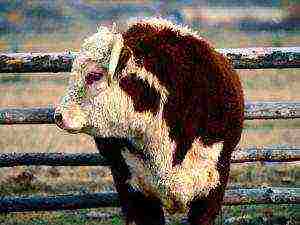 When raising calves for meat, it is better to feed them with one whole milk. The meat after such feeding is light, typical for good veal, it is most appreciated on the market. Skim milk, white bread, and raw chicken eggs can be added temporarily.
When raising calves for meat, it is better to feed them with one whole milk. The meat after such feeding is light, typical for good veal, it is most appreciated on the market. Skim milk, white bread, and raw chicken eggs can be added temporarily.
Care must be taken to ensure that the calf does not overeat, that the room is dry and draft-free, and that it receives chalk. A cage for such an animal is made small so that it cannot jump and spin in it, then the weight gain will go faster.
Feeding is carried out for 2-3 months. A well-fed calf produces a carcass weighing 55–60% of its live weight.
At home, raising calves will require small material investments, but huge labor costs. But no matter what you decide: to raise young animals for dairy farming or for slaughter, in any case, it will pay off.
Video How to raise a calf
Sources:
No comments yet!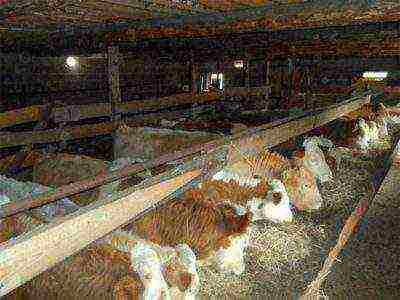
Breeding cattle (bulls) at home for beginners is a profitable business, since the family can be provided with food, and the leftovers can be sold and made a profit.Novice farmers mistakenly think that breeding gobies for meat as a business is a troublesome and costly process.
But with the right organization and adherence to the care requirements, the business will flourish and generate income. Let's take a closer look at whether it is profitable to keep them for meat.
…
Where to begin?
 The initial organization of any business requires certain actions to be followed. Among them - an adequate assessment of their own strengths and capabilities (breeding calves requires dedication and time). It is also important to take into account the conditions of the region, since raising large animals requires large areas. It is impossible to organize the process in an urban area.
The initial organization of any business requires certain actions to be followed. Among them - an adequate assessment of their own strengths and capabilities (breeding calves requires dedication and time). It is also important to take into account the conditions of the region, since raising large animals requires large areas. It is impossible to organize the process in an urban area.
When planning the supply of meat to catering facilities and shops, compulsory business registration will be required.
An important question, on which the specifics of the case depend: "What does the farmer choose: the purchase of young animals or independent breeding?" Buying individuals eliminates a number of problems:
- the acquisition of bull semen (or the maintenance of a breeding bull);
- fertilization;
- organization of a separate building.
REFERENCE! In order for the bull to gain weight, optimal conditions should be created. Growth and development will depend on the amenities created.
Calves should only be kept in dry barns. Stalls should have a solid and secure floor. Daily cleaning is compulsory. It is recommended to clean the floor with a stiff brush and rinse it under running water in warm weather.
Features of the case
The activity is specific. Calves need to be actively fed until a certain age, then slaughtered (or sell by live weight). The peculiarity of the case is a small investment.
The main difficulties are associated with the time and effort spent on caring for the animals. There are usually no problems with the sale of meat products: a wide sales market allows you to quickly sell the finished product.
Among the features of keeping gobies, the following are distinguished:
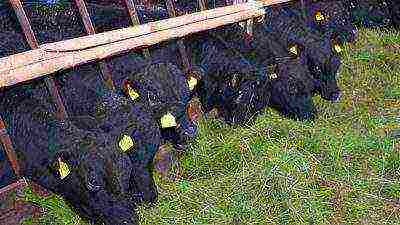 The right choice of leash. The animals will cut off the thin rope. A suitable option is a metal chain made of rings welded together. A piece of cloth should be placed under the collar of the bull to minimize injury to the metal.
The right choice of leash. The animals will cut off the thin rope. A suitable option is a metal chain made of rings welded together. A piece of cloth should be placed under the collar of the bull to minimize injury to the metal.- When growing, you should pay attention to the nature of the individual. Aggressive, wayward and easily excitable males should be discarded as their keeping is unsafe.
- To guarantee safety and convenience at 12 months, the animal needs to have a nose ring installed.
Is it profitable?
The growth period of meat for slaughter is 12 to 20 months. The average weight of one bull is 350 kg. The cost of meat and profit figures will depend on the conditions of each specific region. The case will fully pay off in 1-2 years. Work will only generate income if it is done correctly. To start such a business is necessary for people who are not afraid of physical labor.
ADVICE! If you donate meat directly to shops or restaurants, then the income will be significantly higher than selling it to wholesalers.
Characteristics of a suitable site
The preferred area for growing meat gobies is a plot with a large and free area of land. It can be a mini farm, an old cottage, a private courtyard. There must be a place for organizing a corral and walking the livestock.
In summer, animals will begin to actively gain weight - this will require daily walking (keeping in a stall will increase aggressiveness and cause illness). There should be meadows or grazing fields near the barn.
We equip the building
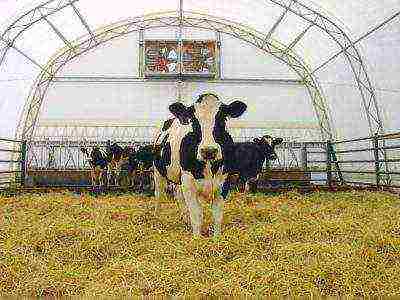 Area for 1 head - 10 sq.m. (includes a place for storing food). A brick or slab is suitable for building a barn (inexpensive, but high-quality material). From an economic point of view, it is more profitable to rent a ready-made complex with everything you need.
Area for 1 head - 10 sq.m. (includes a place for storing food). A brick or slab is suitable for building a barn (inexpensive, but high-quality material). From an economic point of view, it is more profitable to rent a ready-made complex with everything you need.
Bulls are clean animals, therefore The barn should be designed so that it is easy to clean. Attention should be paid to the selected area: water should not accumulate on it.
Barn organization
The characteristics of a suitable building are warmth (at least 8 degrees), good ventilation and the ability to ventilate. Drafts are strictly prohibited - they provoke disease. If the herd size is more than 10 heads, it is better to automate the process of feeding water and feed.
It is important that animals have constant free access to feeders and drinkers (but it is undesirable to put them on the floor, the optimal height is 8-10 cm from the floor level). To clean the air inside the building, farmers use ash - it absorbs ammonia and gases. You can put it on the paths or fall asleep in boxes.
How to choose animals?
When choosing a breed, you need to consider several important indicators:
- Live weight: whether the calf meets breed standards.
- Development level, general physique, presence of defects or deficiencies.
- Calf pedigree (mother's productivity and father's weight).
Purchase of young animals
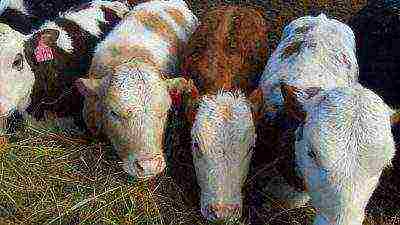 When selecting individuals, you should pay attention to weight (optimal 90-100 kg) and age.
When selecting individuals, you should pay attention to weight (optimal 90-100 kg) and age.
It is preferable to buy young animals on special farms that are engaged in breeding. You can also purchase calves from breeders.
Dairy gobies have a low purchase price (they need to be fed with milk for up to 3 months).
Recommendation! It is better to buy individuals that have already switched to independent consumption of grass and feed. It is preferable to purchase calves in May, then by the fall of next year it will be possible to hand over the money.
Common types
Some characteristics of cultivation and the payback period depend on the breed. Farmers recommend buying fast-growing young animals, but do not forget about the taste characteristics of the meat.
Before choosing a breed, you need to find out which individuals are suitable for keeping in the region of residence (expensive breeding bulls may not take root in a certain area). List of the best breeds:
- charolais;
- Kazakh white-headed;
- simmental;
- hereford.
Content
Young animals should be kept separate from adult bulls (a separate barn should be built for the calves). It is allowed to keep bulls with cows - so the temper of the males will be more calm.
In summer, it is possible to keep gobies in the open air, but the pens will need to be additionally equipped with special plastic booths. Manure is removed 3 times a day, immediately after feeding.
IMPORTANT! The growth of the hoof horn should be controlled. Hooves should be trimmed and trimmed twice a year.
The walking area should be fenced with as strong materials as possible. It is allowed to release adult bulls into the street with a special stick and leash. The stick is fixed in the nose ring of the individual. Simultaneous walking with females or young animals is not recommended.
Food
In productive gobies, the meat index is not less than 70%. To achieve this result, you need to provide intensive feeding. Hay and juicy herbs will not achieve high performance: the diet must contain the following foods:
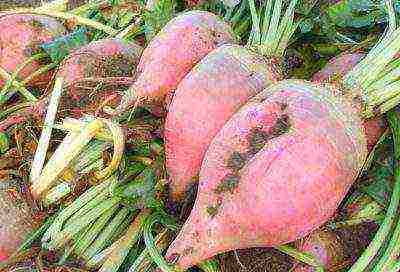 forage beet;
forage beet;- carrots and potatoes (calves need to cook and crush them);
- grain crops;
- salt;
- food waste.
The addition of concentrates will allow the body to replenish the supply of vitamins and microelements. The basis of the diet in winter is hay, compound feed and root crops. In summer, the main product is juicy and fresh grass. Individuals should spend at least 15 hours in the pasture.
About reproduction
How to breed bulls? A breeding bull fertilizes up to 50 cows per year. You can keep it on your own farm or use the services (manual mating - a cow is led to the bull). When mating individuals of different species, crossing or crossbreeding occurs. Among natural breeding technologies:
- manual (mating under control);
- cooking method;
- free method.
Note! Today, methods of natural reproduction are practically not used.
Business
Selling meat is a profitable business that will provide a stable income.The main model of activity is the lease of a plot and the purchase of young stock, its rearing and subsequent sale.
For a payback, the herd size should not be less than 10 heads. It is especially important to create suitable housing conditions and maintain a balanced diet for the animals. Up to 15 heads can be handled on their own, over 15 - hired personnel will be required.
Do you need clearance?
Business registration is a prerequisite for sales and deliveries. The farmer becomes an individual entrepreneur and receives the appropriate quality certificates. Several other options are suitable for registration:
- personal farming (not related to business);
- peasant-farm plot (requires the involvement of partners).
We recruit staff
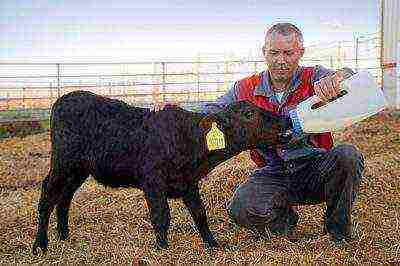 The helpers need to choose people who know how and love to watch the animals. It is also important to pay attention to personal qualities (responsibility, discipline).
The helpers need to choose people who know how and love to watch the animals. It is also important to pay attention to personal qualities (responsibility, discipline).
For a livestock of 20 bulls, 2-3 helpers are enough. Be sure to have a veterinarian on staff. This can be a permanent position or an invited specialist.
Quantitative indicators: spending and profit
Initial costs are spent on equipping the barn, purchasing young stock and purchasing a forage base. On average, it will take up to 500 thousand rubles to open a farm and form a herd of 20 heads.
The cost of feed will be up to 20 thousand per year per 1 bull. Additional costs will appear later: mini-tractor, refrigerator, automatic feeders.
Attention! The initial investment will pay off in 16-18 months. The average amount of net profit is from 400 thousand per year.
Making a plan
The document contains the goal, directions of activity, calculation of costs and benefits. The business plan for raising bull calves for meat, breeding and keeping a herd of 20 heads includes the following costs:
- Buying young animals.
- Rent and subsequent arrangement of the barn.
- Veterinary control and purchase of feed.
Is it profitable to breed gobies for meat? Revenues are calculated based on current prices. The estimated amount and the period of partial and full payback must be included in the business strategy.
Raising calves for meat is an economically profitable undertaking. Remember that these activities are time consuming, costly and physically demanding. With the right organization and reasonable distribution of processes, you can establish a customer base and get a stable profit.
Useful video
We watch a video about raising bulls for meat:
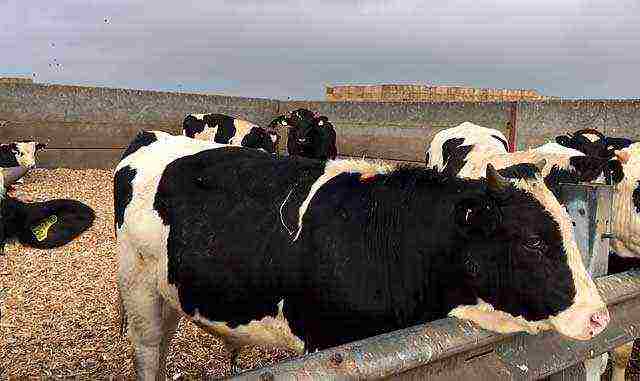
Now raising gobies for meat at home is experiencing another boom. But not all novice breeders clearly understand all the subtleties and nuances in the maintenance and fattening of calves for meat. The result is wasted time, nerves and money. To be honest, the business is really profitable, although at first you will have to spend a little and sweat a lot. If this does not scare you, then below we will tell you about the main points of the purchase, maintenance, nutrition and sale of meat gobies.
Purchase of calves
The first mistake breeders make is saving on calves. People buy the cheapest calf from the first cow they come across. The fact is that there are dairy, meat and mixed cattle breeds. So for fattening for meat, you need to take either meat or mixed breeds. If you take a purely dairy goby, then by one and a half years it will at best grow to 300 kg, which will barely pay back the money spent on it.

Speaking specifically about the breeds, in Russian conditions the best results are shown by the breeds:
- charolais;
- Kazakh white-headed;
- Simmental breed;
- Hereford breed.
This is not to say that any breed is better or worse. But, for example, from Charolais bulls and from Herefords, with appropriate nutrition, you can get real marbled beef. True, you will have to spend a lot on feed, plus special care is needed there, in general, for a small farm it is expensive.
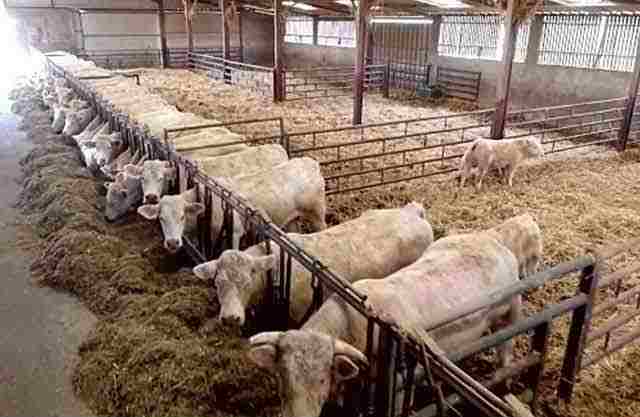
There is one more thing.It is advisable to take the calves with all the necessary vaccinations. This information is in the documents for the bull, so if it is not possible to go to the farm with a veterinarian, then make inquiries and write out for yourself which vaccinations are being given in your area.
Arrangement of premises
For raising bulls at home, one "seedy" barn is not enough. Remember - a goby is not a pig, and if you close it in a confined space and feed it abundantly, it will start to hurt at first. And then, if he lives to the age of slaughter, then there can be no talk of any lean beef, the bull will simply get fat.
According to the rules, in order to raise one bull for meat, he must first build a barn of at least 12 square meters. m. For a good set of muscle mass, the bull needs to be taken out to the pasture every day. If there are no pastures nearby, then you will still have to build a summer enclosure with a canopy, where for each goby there will already be from 30 sq. m.
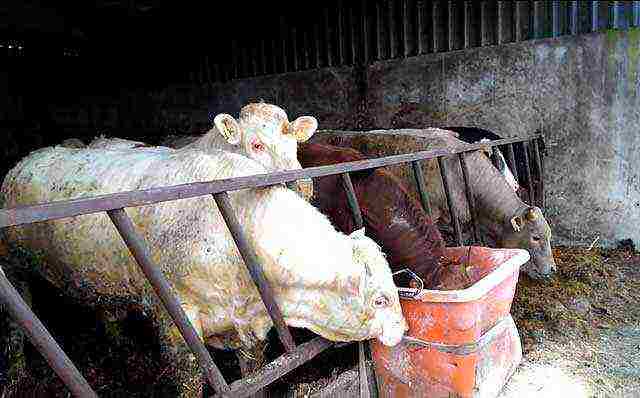
Another problem is drafts and frosts. In winter, the temperature in the stable should not drop below 10 degrees. To maintain it constantly, you will have to insulate windows and doors, and then put a stove in the room. Gobies are even more afraid of drafts than frost. Up to six months, a calf can catch a cold from the slightest draft.
It is advisable to make floors in stalls with a slope and equip them with a manure channel at the end. The most effective way to keep it clean and dry is to clean 2 times a day and sprinkle everything with charcoal.
Feeding dairy calves
Some novice breeders buy very small calves in an effort to save money. Indeed, a monthly calf will cost at least 2 times less than a bull calf 3-4 months old. But feeding such calves requires patience, knowledge and additional financial investments.
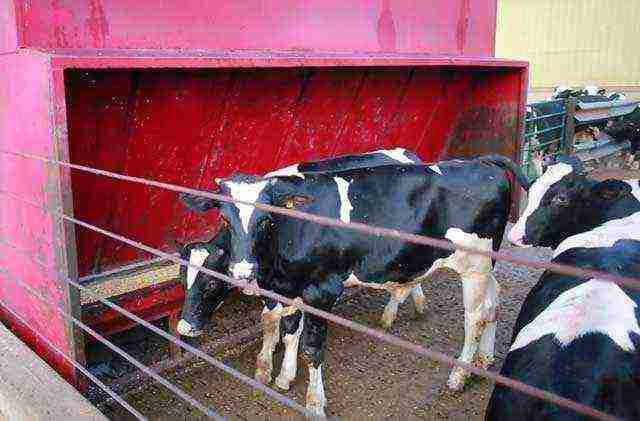
The calf is still dairy, so every day he will have to feed 6-8 liters of milk. It is impossible to feed a baby with milk alone, because the scar (accumulative part of the stomach) should stretch. To do this, he needs to be given oatmeal jelly and grated root vegetables, potatoes, pumpkin, etc. every day. In the warm season, from the age of one month, the calf can be taken out to the meadow. In winter, be sure to give hay.
By the way, in winter, even in frost, calves need to be taken out for a walk at least for a short time, such a hardening exercise will provide your young animals with good health.
From 3 months, so-called starting compound feeds are introduced into the calf's diet. With these mixtures, it is easier to feed calves to coarse food, plus they receive the full amount of nutrients. By the age of 4 months, hay, root crops and compound feed already account for the lion's share of the diet, and by six months the calves switch to the adult menu.
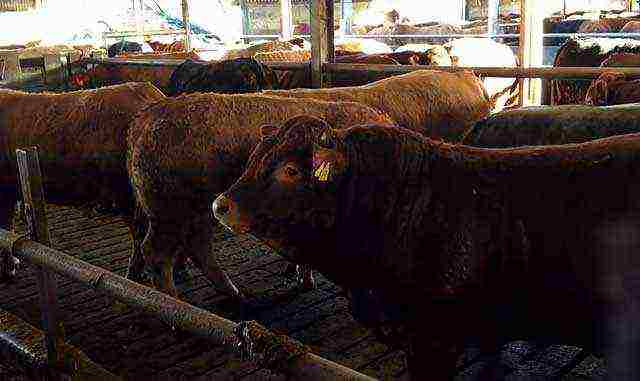
Fattening bulls
Practice has shown that buying dairy calves and feeding them independently is no cheaper than purchasing a ready-made four-month-old calf. Add to this the risk of disease and the cost of vaccinations. It will immediately become clear that it is better not to bother, but to immediately take grown and prepared gobies.
At 4 months, milk already acts as a top dressing, and it is not necessary to buy real cow's milk, you can use dry mixes and even whey. In this case, it is important to concentrate on nutritious feed.
In breeding farms, they try to distribute the work so that the calves are born in winter. Accordingly, by the end of April, you can already buy a formed goby, which can be taken out to the pasture.
But fattening meat has its own characteristics. Even the most "elegant" floodplain meadows will not give the desired weight gain. Moreover, the proportion of hay or succulent grass should be about 30-40%. The rest of the diet of calves is selected from cereals, legumes and energy-rich compound feeds, do not forget about root crops.
From six months, gobies can be given potato peelings, but in the first 2-3 months these peelings need to be boiled and pounded.
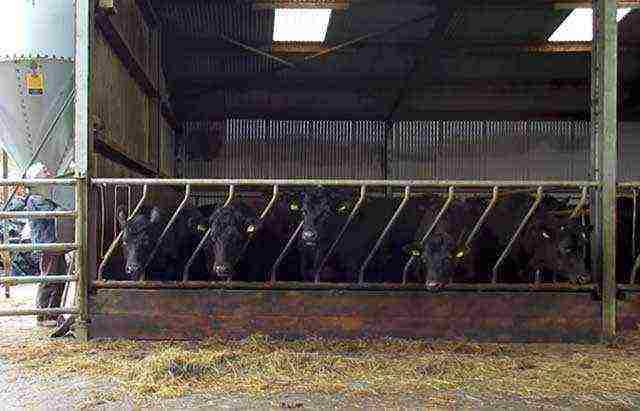
Is castration of calves necessary
Now experts do not have a consensus about the castration of beef calves. If a bull is castrated, it will become calm and peaceful. Accordingly, free-grazing calves will no longer mutilate themselves. Again, a castrated calf has a significant increase in appetite, which young breeders are incredibly happy about.
But seasoned farmers know that the good appetite of a castrated bull does not guarantee the same weight gain. In such calves, energy is more processed into fat mass than into muscles. There is, of course, an option to drive such a bull, but these procedures can lead to weight loss.
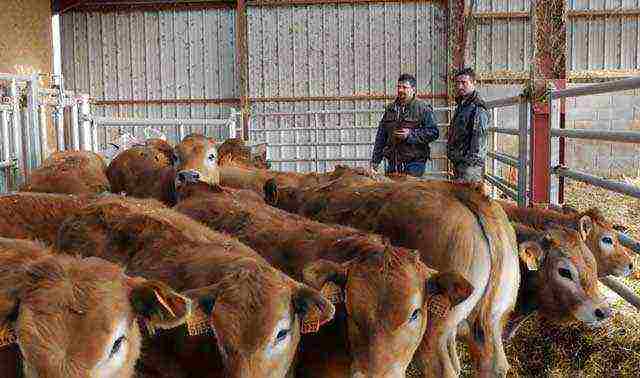
What you definitely can't do is castrate a bull at an early age, you will ruin the calf. Meat breeds are capable of fertilization as early as 6 months, which means that at this time they become more aggressive. But if the bull is castrated at six months, then growth will seriously slow down. Therefore, in order to maintain the ability to gain muscle mass, it is advisable to castrate bulls not earlier than a year.
Costs and profits
To begin with, it makes sense to engage in such a business only in rural areas. Moreover, it is desirable that the meadows are accessible. If you drive calves through the mountains, then they will never gain weight. And next to the swamps, animals will simply be poisoned. To build a more or less decent barn, at least 20-30 heads, you will have to spend from 300 thousand rubles. Plus nice meadows may also need to be rented.
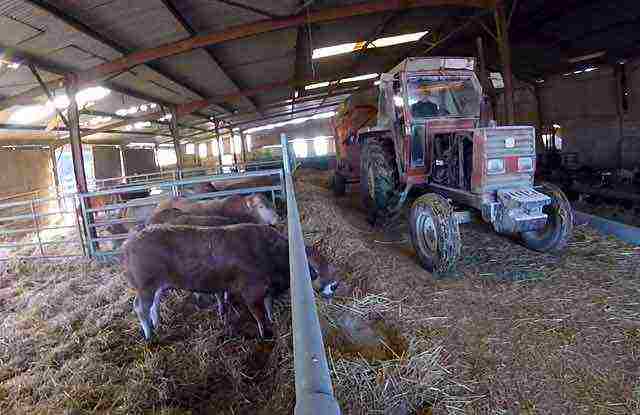
On average, it takes about 15 thousand rubles to feed one bull. If you keep 5-7 heads, then although it is difficult, it is still possible to take care of the calves yourself. When there are more animals, you will have to hire a shepherd and a couple of cattlemen. For households up to 10 heads, the tax office has no claims, then you will have to issue an individual entrepreneur. Plus, you need equipment for the preparation and delivery of feed.
As for the profit, the situation is something like this. The goby is slaughtered at 18-20 months. The useful yield from such bulls ranges from 60 to 80%. Normal slaughter weight is 400-500 kg. The benefits of selling in bulk are small. Profitability will skyrocket if you slaughter the bulls and sell the meat yourself.
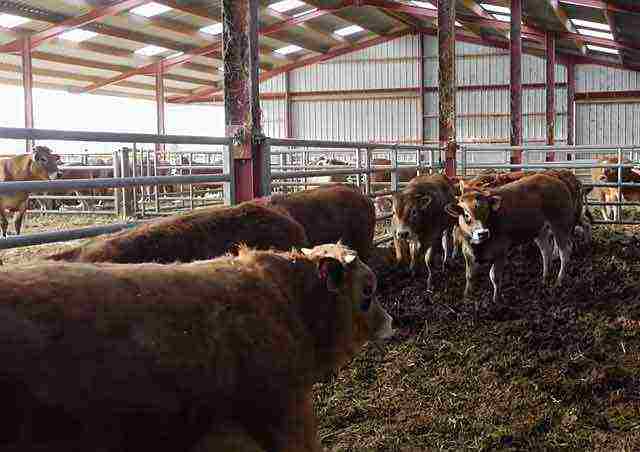
Use of medications
Another controversial issue is the use of drugs that stimulate muscle growth. Such medicines are divided into 2 directions. The first direction activates the body's work, as a result of which muscles grow. The second is represented by steroid feeds and anabolic steroids.
Ideally, any medical intervention in this area is highly undesirable. But in practice, the application or rejection of this method remains on the conscience of the breeders themselves. The Sanitary Epidemiological Station on the market is indifferent to steroids, but supermarket owners, restaurant owners and advanced consumers can easily identify such drugs with the help of special tests.
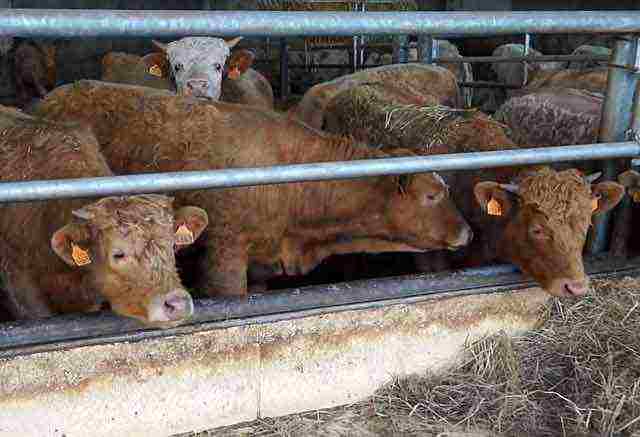
Plus breeding calves for meat at home provides that you and your family will eat some of this meat. And now you rarely find a person who agrees to feed his children with meat stuffed with steroids.
The beef calf business will only grow. We will not argue that this is daunting, but a lazy amateur has nothing to do there. Share the article with your friends and perhaps your like will keep someone from rash decisions or, on the contrary, will arouse interest in this business.
